
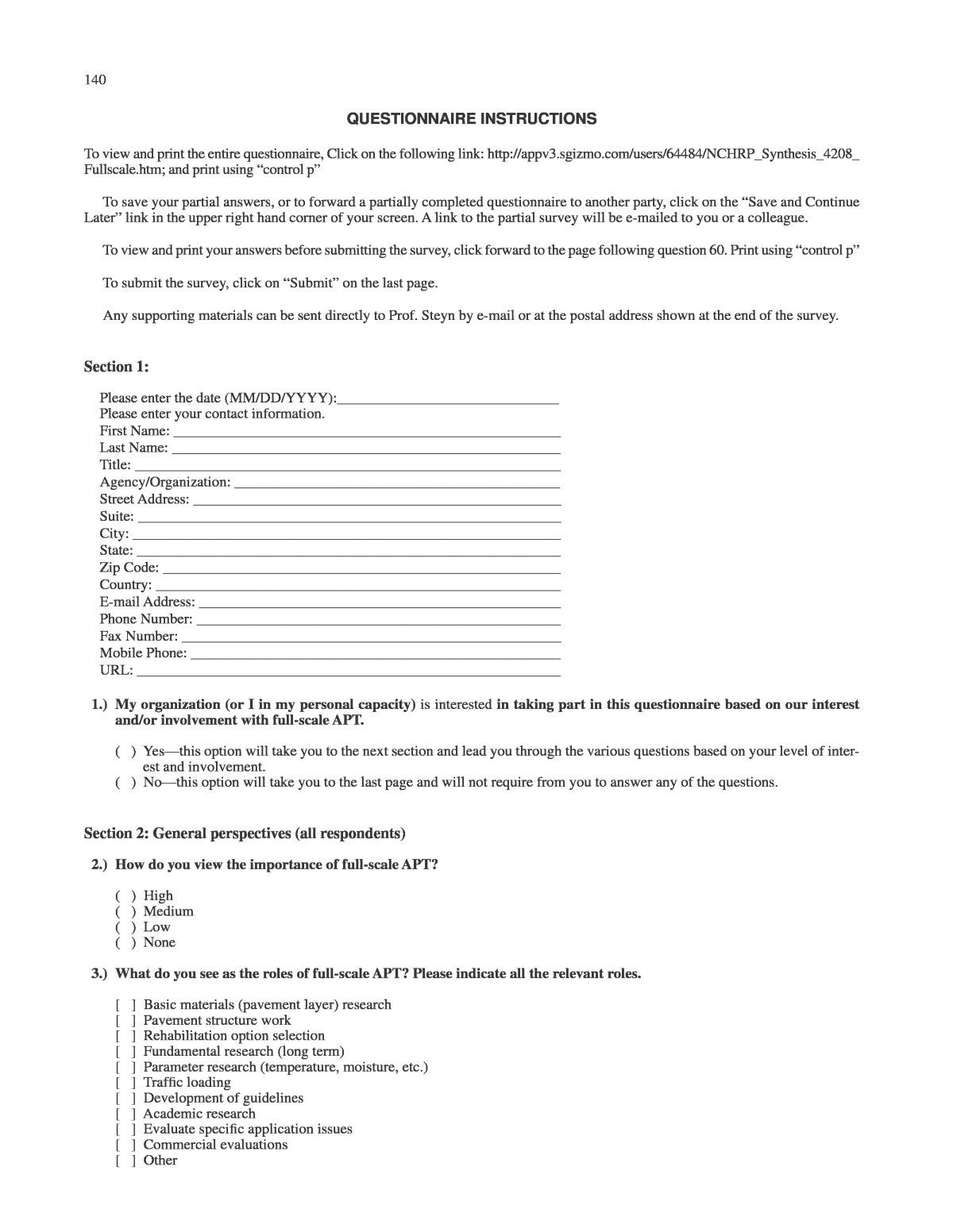


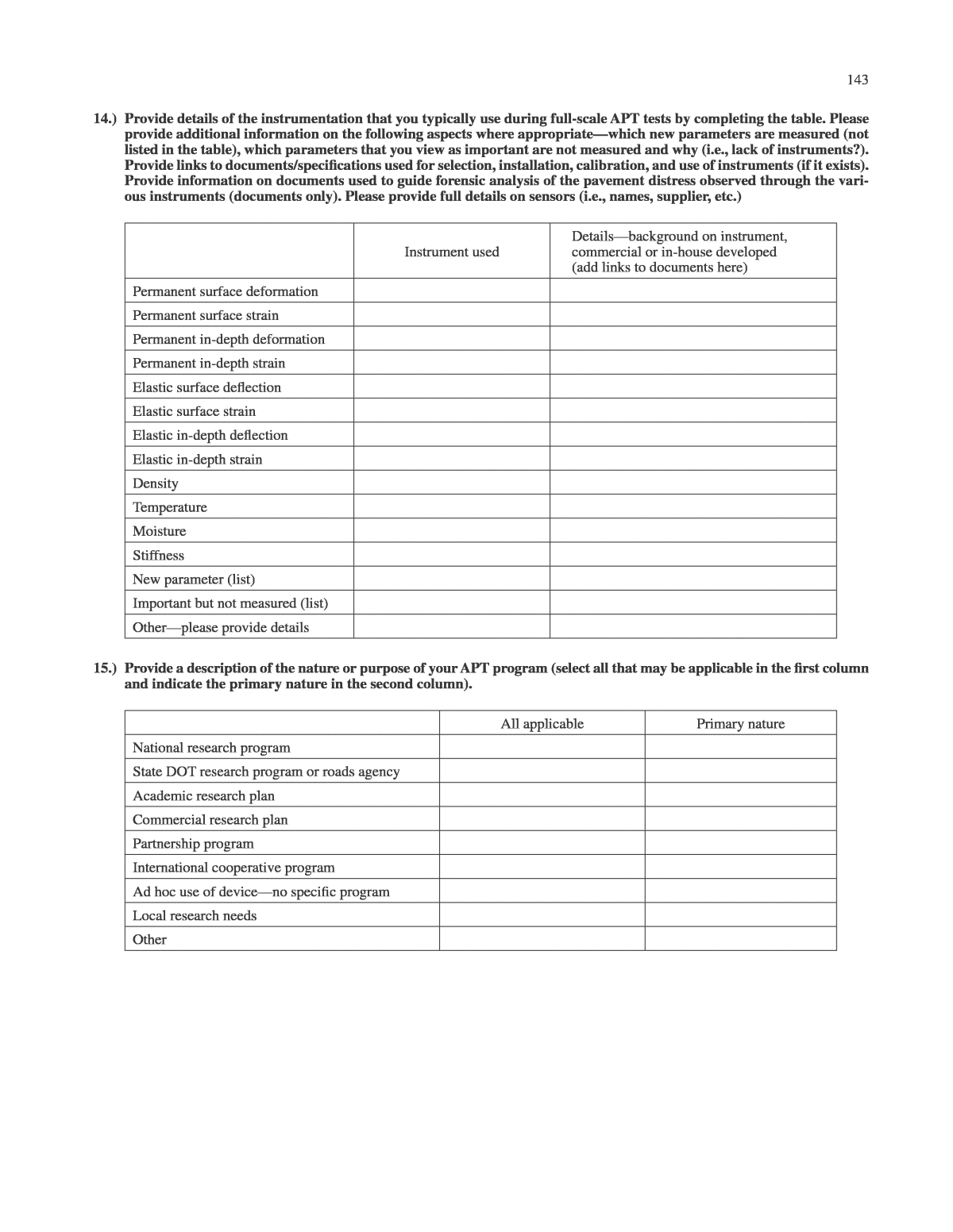
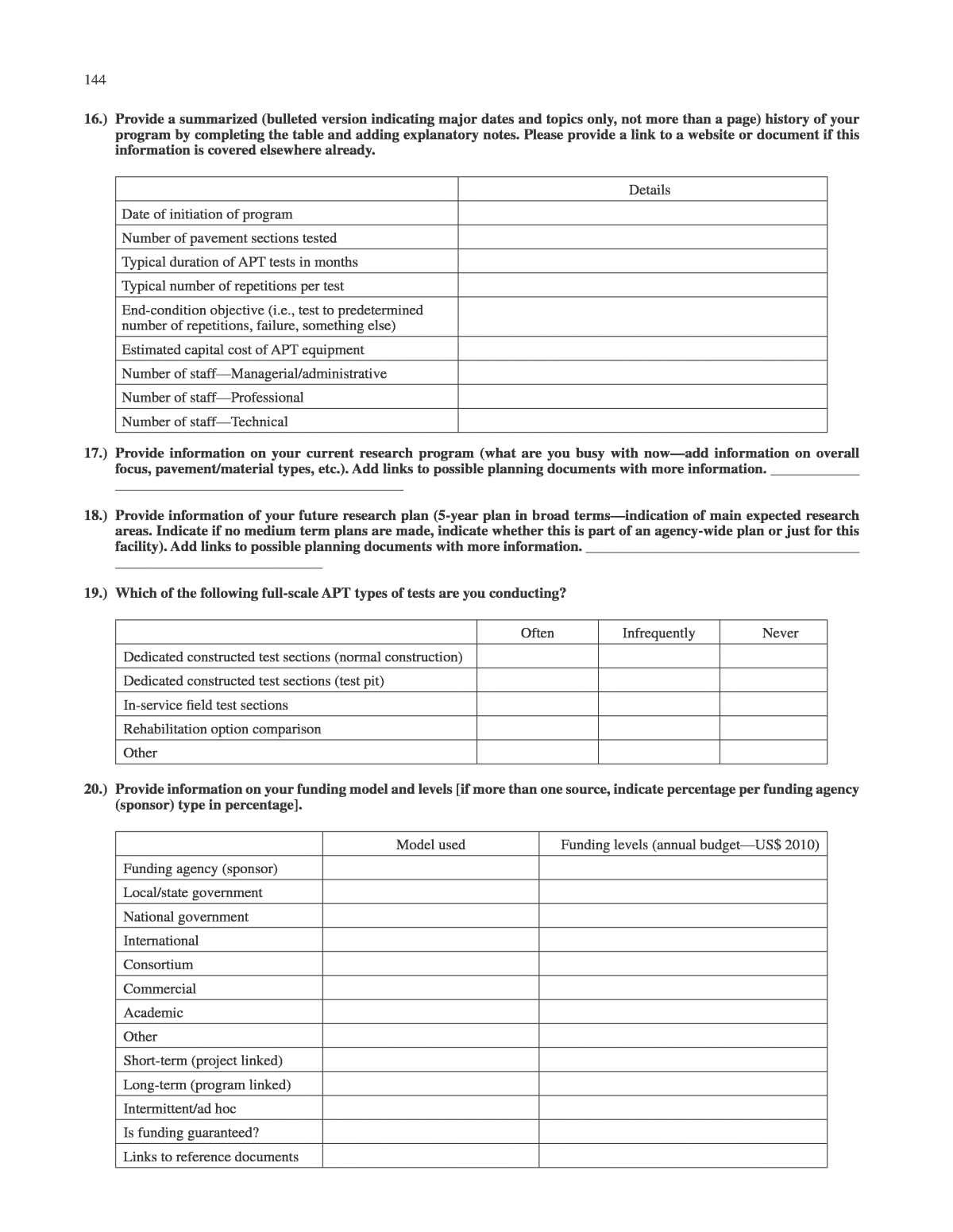



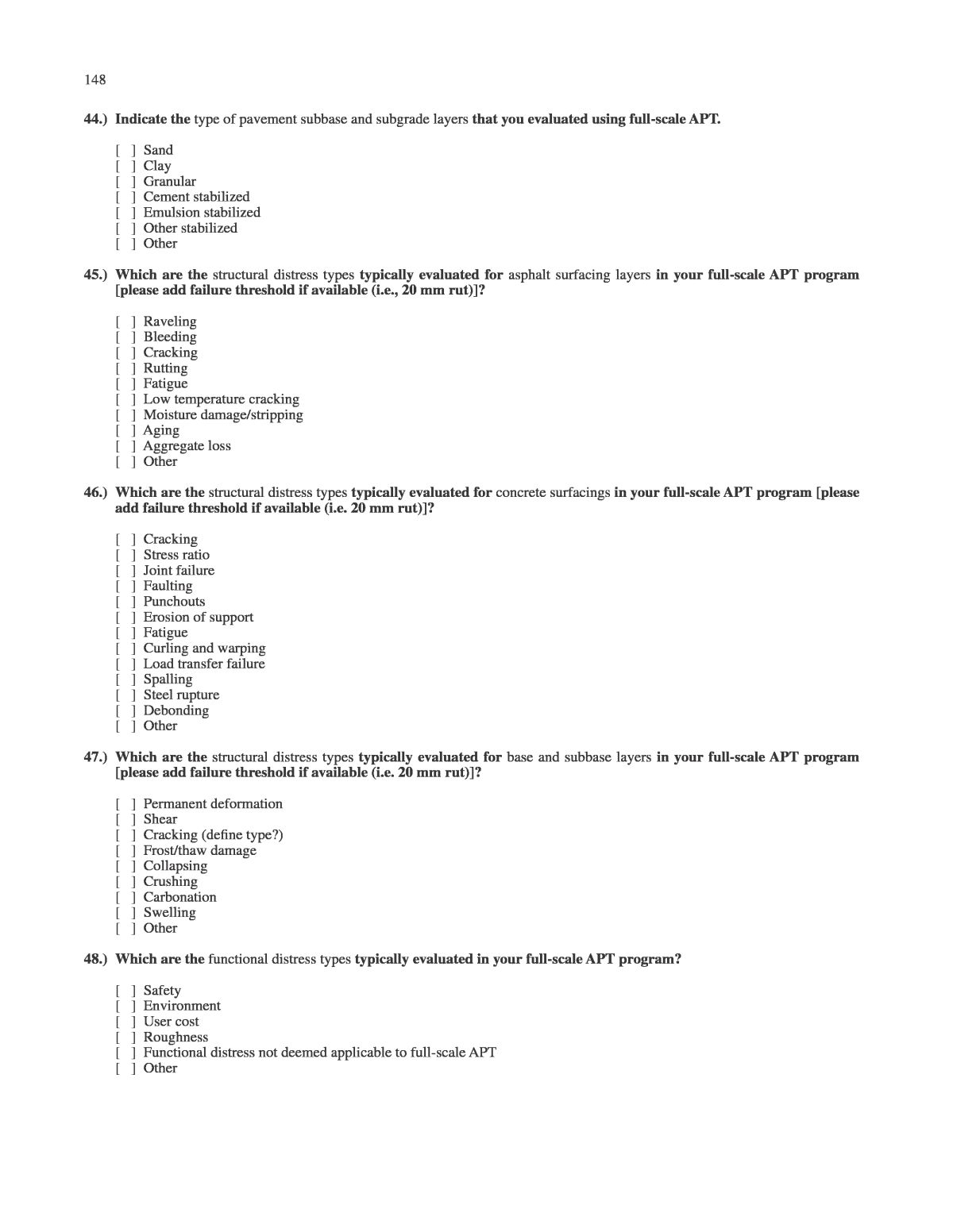

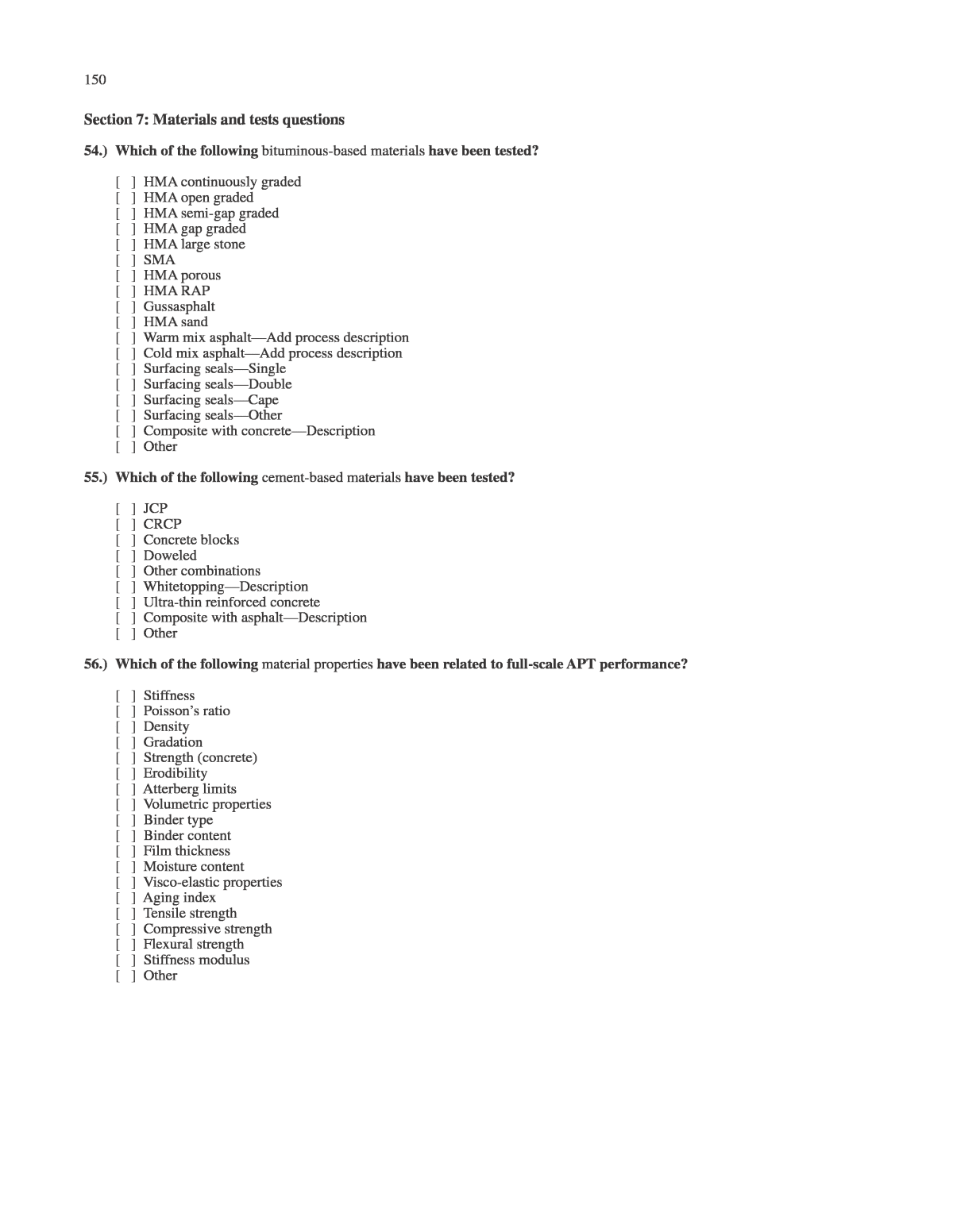


Below is the uncorrected machine-read text of this chapter, intended to provide our own search engines and external engines with highly rich, chapter-representative searchable text of each book. Because it is UNCORRECTED material, please consider the following text as a useful but insufficient proxy for the authoritative book pages.
139 NCHRP Synthesis 42-08: Full-Scale Accelerated Pavement Testing Section 1: Administrative information Dear Full-scale APT owner, manager, researcher or interested party The Transportation Research Board (TRB) is preparing a synthesis on Significant Findings From Full-Scale Accelerated Pavement Testing. This is being done for the National Cooperative Highway Research Program, under the sponsorship of the American Association of State Highway and Transportation Officials, in cooperation with the Federal Highway Administration. This questionnaire is part of the effort in NCHRP Synthesis Topic 42-08 to gather information on the respondentsâ perspectives on significant findings from full-scale accelerated pavement testing (APT). There are 10 sections in the questionnaire and a total of 60 questions. The sections cover general perspectives on full-scale APT, full-scale APT device owner and research program manager questions, and full-scale APT researcher and engineer questions. The first two sections should be completed by all respondents, while the remaining sections should be completed by one representative of each full-scale APT device/research program or researchers and engineers involved in the specific program. Documentation If there is any specific documentation that you would like to submit to the project team, please contact the Principal Investigator (wynand.steyn@up.ac.za) for the most appropriate channel to submit these. There are several questions in the questionnaire where a text box is provided for supplying more information. Please do not use carriage returns when entering data in these text boxes, rather paste text as one large paragraph. Where documents exist that summarize such information, you are welcome to either provide the link to the document (if it is available on a website) or indicate that you send the document via a separate e-mail. This procedure is followed to save you time on completing the questionnaire. This questionnaire is sent to owners and managers of full-scale APT facilities, researchers using APT data, and all U.S. state depart- ments of transportation. Your cooperation in completing the questionnaire will ensure the success of this effort. If you are not the appropriate person at your agency or facility to complete this survey, please forward it to the correct person, or send an e-mail to the Principal Investigator indicating the correct contact person. Please complete and submit this survey by 8 April 2011. We estimate that it should take no more than 45 minutes to complete Sections 1 and 2 (information for all participants) and another 180 minutes to complete the remainder of the questionnaire (for APT device owners and data users). If you have any questions, please contact our principal investigatorâProf. Wynand JvdM Steyn at: wynand.steyn@up.ac.za, Tel +2712 4202171 (South Africa), Skypeâwynandjvdms appenDix a Survey Questionnaire
140 QueStionnaire inStructionS To view and print the entire questionnaire, Click on the following link: http://appv3.sgizmo.com/users/64484/NCHRP_Synthesis_4208_ Fullscale.htm; and print using âcontrol pâ To save your partial answers, or to forward a partially completed questionnaire to another party, click on the âSave and Continue Laterâ link in the upper right hand corner of your screen. A link to the partial survey will be e-mailed to you or a colleague. To view and print your answers before submitting the survey, click forward to the page following question 60. Print using âcontrol pâ To submit the survey, click on âSubmitâ on the last page. Any supporting materials can be sent directly to Prof. Steyn by e-mail or at the postal address shown at the end of the survey. Section 1: Please enter the date (MM/DD/YYYY):______________________________ Please enter your contact information. First Name: _____________________________________________________ Last Name: _____________________________________________________ Title: __________________________________________________________ Agency/Organization: ____________________________________________ Street Address: __________________________________________________ Suite: _________________________________________________________ City: __________________________________________________________ State: ____________________________________________________ _____ Zip Code: ______________________________________________________ Country: _______________________________________________________ E-mail Address: _________________________________________________ Phone Number: _____________________________________________ ____ Fax Number: ______________________________________________ _____ Mobile Phone: __________________________________________________ URL: ______________________________________________________ ___ 1.) My organization (or I in my personal capacity) is interested in taking part in this questionnaire based on our interest and/or involvement with full-scale APT. ( ) Yesâthis option will take you to the next section and lead you through the various questions based on your level of inter- est and involvement. ( ) Noâthis option will take you to the last page and will not require from you to answer any of the questions. Section 2: General perspectives (all respondents) 2.) How do you view the importance of full-scale APT? ( ) High ( ) Medium ( ) Low ( ) None 3.) What do you see as the roles of full-scale APT? Please indicate all the relevant roles. [ ] Basic materials (pavement layer) research [ ] Pavement structure work [ ] Rehabilitation option selection [ ] Fundamental research (long term) [ ] Parameter research (temperature, moisture, etc.) [ ] Traffic loading [ ] Development of guidelines [ ] Academic research [ ] Evaluate specific application issues [ ] Commercial evaluations [ ] Other
141 4.) What do you see as the future of APT? Please indicate all relevant options. [ ] Everything has been doneâclose it [ ] Normal part of operation when required [ ] Growing [ ] Simulations and advanced computer analyses should be used [ ] Other 5.) What do you view as the benefits of full-scale APT? Please indicate all relevant options. [ ] None [ ] Improved structural design methods [ ] Improved material design methods [ ] Evaluation of novel materials and structures [ ] Development of performance-related specifications [ ] Material databases [ ] Improved performance modeling [ ] Improved pavement management [ ] Better understanding of variability [ ] Warranty contracts [ ] Weather databases [ ] Other 6.) What are the main opportunities to disseminate full-scale APT research information? Please indicate all relevant options. [ ] General engineering conferences [ ] Focused transportation conferences [ ] Focused pavement engineering conferences [ ] Focused APT conferences [ ] General engineering journals [ ] Focused transportation journals [ ] Focused pavement engineering journals [ ] Focused APT journals [ ] Electronic journals [ ] Meetings such as TRB [ ] Other 7.) What is your perception of the way that APT has/should change the pavement engineering world? Please indicate all relevant options. [ ] Academic benefits [ ] Internal organizational training and education [ ] Fundamental understanding of pavement structures [ ] Development of new materials [ ] Proving new techniques and materials [ ] Specific examples in your area [ ] Other 8.) In which local/international APT forums are you active? Indicate those forums and please provide more details on the forums that you are active in next to the section [level of involvement, duration of involvement (history), role in pro- gram, permanent or ad hoc] in the additional details column. TRB AFD40: _________________________ COST: _________________________ HVSIA: _________________________ MLS user group: _________________________ South African APT advisory committee: _________________________ NCAT: _________________________ CAPT: _________________________ FEHRL: _________________________ Midwest States Accelerated Pavement Testing Pooled Fund Program (states of Iowa, Kansas, Nebraska and Missouri): _________________________ APT conferences: _________________________ TERRA: _________________________ Other: _________________________
142 9.) What do you view as the most significant finding of full-scale APT in the last decade (since 2000)? Please respond in terms of your own program as well as your perception of international programs. Also indicate your perception of any significant future findings required (holy grails). Most significant findingâown full-scale APT program: _________________________ Most significant findingâinternational full-scale APT program: _________________________ Future significant findings required: _________________________ 10.) Do you own a full-scale APT device? ( ) Yes ( ) No 11.) Do you have access to a full-scale APT device (and therefore APT data that you can analyze)? [ ] Yes (Continue to Question 12) [ ] No (Questionnaire completedâgo to end) Section 3: Full-scale APT device owner and research program managers 12.) Describe the type of access that you have to a full-scale APT device. [ ] Own [ ] Rental [ ] Borrow without financial cost [ ] Share [ ] Part of consortium [ ] Other 13.) Provide details of the full-scale APT device that you own/use. Description according to selection of specific options. Please provide a website link to your full-scale APT device homepage where more details are available (including official photos) Selection Additional information Mobile/fixed Linear/non-linear (circular, elliptical) Uni/bi-directional loading Number of axles Own power (diesel/electric/other)/shore power Field site/fixed site Roads/airfields Fixed device/trucks (automated or manually driven) Load range (range in kNâindicate full load for all tires as well as range per tire) Tire details (size, type, inflation pressure range, other) Tire wander options Suspension (present or not, types possible, permanent or not, etc.) Temperature control options Speed range Dedicated operational data collection on full-scale APT device during operation (i.e., applied speed, load, loca- tion, etc.)? APT webpage link Other
143 14.) Provide details of the instrumentation that you typically use during full-scale APT tests by completing the table. Please provide additional information on the following aspects where appropriateâwhich new parameters are measured (not listed in the table), which parameters that you view as important are not measured and why (i.e., lack of instruments?). Provide links to documents/specifications used for selection, installation, calibration, and use of instruments (if it exists). Provide information on documents used to guide forensic analysis of the pavement distress observed through the vari- ous instruments (documents only). Please provide full details on sensors (i.e., names, supplier, etc.) Instrument used Detailsâbackground on instrument, commercial or in-house developed (add links to documents here) Permanent surface deformation Permanent surface strain Permanent in-depth deformation Permanent in-depth strain Elastic surface deflection Elastic surface strain Elastic in-depth deflection Elastic in-depth strain Density Temperature Moisture Stiffness New parameter (list) Important but not measured (list) Otherâplease provide details 15.) Provide a description of the nature or purpose of your APT program (select all that may be applicable in the first column and indicate the primary nature in the second column). All applicable Primary nature National research program State DOT research program or roads agency Academic research plan Commercial research plan Partnership program International cooperative program Ad hoc use of deviceâno specific program Local research needs Other
144 16.) Provide a summarized (bulleted version indicating major dates and topics only, not more than a page) history of your program by completing the table and adding explanatory notes. Please provide a link to a website or document if this information is covered elsewhere already. Details Date of initiation of program Number of pavement sections tested Typical duration of APT tests in months Typical number of repetitions per test End-condition objective (i.e., test to predetermined number of repetitions, failure, something else) Estimated capital cost of APT equipment Number of staffâManagerial/administrative Number of staffâProfessional Number of staffâTechnical 17.) Provide information on your current research program (what are you busy with nowâadd information on overall focus, pavement/material types, etc.). Add links to possible planning documents with more information. ____________ _______________________________________ 18.) Provide information of your future research plan (5-year plan in broad termsâindication of main expected research areas. Indicate if no medium term plans are made, indicate whether this is part of an agency-wide plan or just for this facility). Add links to possible planning documents with more information. _____________________________________ ____________________________ 19.) Which of the following full-scale APT types of tests are you conducting? Often Infrequently Never Dedicated constructed test sections (normal construction) Dedicated constructed test sections (test pit) In-service field test sections Rehabilitation option comparison Other 20.) Provide information on your funding model and levels [if more than one source, indicate percentage per funding agency (sponsor) type in percentage]. Model used Funding levels (annual budgetâUS$ 2010) Funding agency (sponsor) Local/state government National government International Consortium Commercial Academic Other Short-term (project linked) Long-term (program linked) Intermittent/ad hoc Is funding guaranteed? Links to reference documents
145 21.) Provide typical information of cost of APT (no commercially sensitive information needs to be provided). Indicate the number of years and type of projects on which the cost is based (i.e., 10 years of dedicated long-term tests or 1 year of 8 ad hoc tests). Total budget (US$ 2010) Number of years Type of projects Total budget Operational budget Maintenance budget Staff budget Construction budget Average US$ per standard repetition (one direction) for a typical 1 year program (not short term studies) Links to reference documents 22.) Provide an indication of any planned new developments on your device (updates to device, new instruments, new initia- tives, etc.). ______________________________________________________ 23.) Provide information on the way in which you combine full-scale APT, laboratory testing, field testing, and long-term pavement performance (LTPP) in your program (LTPP refers to both SHRP LTPP sections as well as local LTPP sec- tions that are not part of the SHRP LTPP sections). Select all applicable options. [ ] APT and laboratory [ ] APT and LTPP [ ] APT and field [ ] APT, laboratory and LTPP [ ] APT, laboratory and field [ ] APT, laboratory, field and LTPP [ ] Other [ ] Links to reference documents 24.) Provide information on the major specific tests that were conducted during the last decade. These are your major/ significant achievements. What was the effect of these programs on your department/research group/commercial activi- ties, etc. (Objective, materials/structure, type of funding, type of outputs, etc.)? _________________________________ ______________________ 25.) Provide an indication of the standard way in which full-scale APT information from your program is being dissemi- nated into industry (provide information for academic dissemination, commercial dissemination, and industry dis- semination). Please provide official links to information (official website/database with reference lists and downloadable papers/reports if available) in the text boxes. [ ] Academic dissemination (i.e., dissertations and theses) [ ] Commercial dissemination (i.e., reports, websites, news releases, etc.) [ ] Funding agency (sponsor) dissemination (reports, other) [ ] Industry dissemination (i.e., reports, websites, news releases, etc.) [ ] Conferences, meetings, and journals [ ] Other (i.e., organization database, organization website, wikis, etc.) 26.) What do you perceive as the major influence that your full-scale APT program had on academia/industry over the last 5 to 10 years? Did it make a measureable difference? _________________________________________________________________________________ 27.) How do you measure/evaluate the benefit of your program in industryâbenefit/cost studies, economic analyses, seminar feedback, others? Provide indications of calculated parameters (i.e., benefit cost ratios) where applicable, or links to reports with this information. __________________________________________________________________________________
146 28.) What is your estimate of the return on investment (cost benefit ratio) for your facility for the testing performed? Please add references to supporting literature where available. ( ) 1 to 5 ( ) 6 to 10 ( ) 11 to 20 ( ) 21 to 30 ( ) 31 and up 29.) Why are you currently continuing with your APT program? __________________________________________________________________________________ 30.) Provide information on the type of database or storage method that is used to store data in your APT program (only relevant to owners of APT devices). _________________________________________________________________________________ 31.) Do you make data from your APT program available to other researchers (not directly linked to your APT program) for analysis? What processes are followed to enable such researchers to obtain access to this data? (only relevant to owners of APT devices). [ ] Data available to non-APT owners [ ] Data shared with other APT programs [ ] Process used [ ] Links to reference documents Section 4: Full-scale APT researcher/engineer/user (this section is to be completed by all APT data usersâregardless of whether you use your own device or not) 32.) Where do the data that you use in your research originate from? [ ] Focused research programâown organization [ ] Focused research programâother organization [ ] Full-scale APT databaseâown organization [ ] Full-scale APT databaseâother organization [ ] Other 33.) Do you only use data from individual sections in your research or a combination of selected sections or a whole research program? [ ] Individual sections [ ] Combinations [ ] Others 34.) Who is your typical client (select all applicable)? ( ) Funding agency (sponsor) ( ) State DOT/roads agency ( ) Academic institution ( ) External clients (non-commercial) ( ) External clients (commercial) ( ) Other 35.) How do you combine full-scale APT, laboratory, field, and LTPP data in your research? _______________________________________________________________________________ 36.) How often are full-scale APT data used in conducting graduate studies (masters or doctorate level)? [ ] All projects [ ] Selected projects [ ] Only ad hoc [ ] Never
147 37.) How many Masters and Doctorate degrees were completed based on (partly or fully) full-scale APT data between 2000 and 2010 (provide links to copies of theses)? Completed Current Links to theses Masters Doctorate Other 38.) What is the importance of economic analyses of the investigated technology in your research program? [ ] Conducted during test planning as motivation [ ] Conducted afterwards as standard step [ ] Conducted afterwards as ad hoc activity [ ] Not done 39.) Which techniques do you use to conduct these economic analyses? _____________________________________________________________________________________ 40.) Provide a list of your personal papers/reports on full-scale APT over the last decade (full references required as per standard TRB paper requirements). If these are located in a web-accessible database/site, please provide the address. If possible, please indicate the field of interest of each specific document (general APT, materials, pavement structure, modeling/analysis, program evaluation, instrumentation). __________________________________________________ Section 5: The following questions are more detailed with respect to actual studies and detailed aspects of full-scale APT. 41.) What is the basis of the selection of full-scale APT test sections in your program? [ ] Official research program [ ] Ad hoc test selection [ ] Academic interest [ ] Other 42.) Indicate the type of surfacing pavement layers that you evaluated using full-scale APT. [ ] Unpaved [ ] Seal/bitumen surface treatment [ ] Hot mix asphalt [ ] Warm mix asphalt [ ] Cold mix asphalt [ ] Concrete (all thick concrete pavement layers) [ ] Ultra-thin reinforced concrete [ ] Ultrathin white-topping [ ] Composites [ ] Other 43.) Indicate the type of pavement base layers that you evaluated using full-scale APT. [ ] Sand [ ] Clay [ ] Granular [ ] Cement stabilized [ ] Emulsion stabilized [ ] Other stabilized (define) [ ] Asphaltic [ ] Composite [ ] Recycled [ ] Other
148 44.) Indicate the type of pavement subbase and subgrade layers that you evaluated using full-scale APT. [ ] Sand [ ] Clay [ ] Granular [ ] Cement stabilized [ ] Emulsion stabilized [ ] Other stabilized [ ] Other 45.) Which are the structural distress types typically evaluated for asphalt surfacing layers in your full-scale APT program [please add failure threshold if available (i.e., 20 mm rut)]? [ ] Raveling [ ] Bleeding [ ] Cracking [ ] Rutting [ ] Fatigue [ ] Low temperature cracking [ ] Moisture damage/stripping [ ] Aging [ ] Aggregate loss [ ] Other 46.) Which are the structural distress types typically evaluated for concrete surfacings in your full-scale APT program [please add failure threshold if available (i.e. 20 mm rut)]? [ ] Cracking [ ] Stress ratio [ ] Joint failure [ ] Faulting [ ] Punchouts [ ] Erosion of support [ ] Fatigue [ ] Curling and warping [ ] Load transfer failure [ ] Spalling [ ] Steel rupture [ ] Debonding [ ] Other 47.) Which are the structural distress types typically evaluated for base and subbase layers in your full-scale APT program [please add failure threshold if available (i.e. 20 mm rut)]? [ ] Permanent deformation [ ] Shear [ ] Cracking (define type?) [ ] Frost/thaw damage [ ] Collapsing [ ] Crushing [ ] Carbonation [ ] Swelling [ ] Other 48.) Which are the functional distress types typically evaluated in your full-scale APT program? [ ] Safety [ ] Environment [ ] User cost [ ] Roughness [ ] Functional distress not deemed applicable to full-scale APT [ ] Other
149 49.) Which functional safety aspects were evaluated? [ ] Rutting [ ] Skid resistance [ ] Punchouts [ ] Delamination [ ] Roughness [ ] Spalling [ ] Functional aspects not deemed applicable to full-scale APT [ ] Other 50.) Which environmental aspects are typically evaluated during full-scale APT? [ ] Noise [ ] Dust pollution [ ] Not deemed applicable to full-scale APT [ ] Other Section 6: Loading and environment questions 51.) To which of the following load characteristics do you relate full-scale APT data? [ ] Applied wheel load [ ] Tire inflation pressure [ ] Tire contact stress [ ] Tire type [ ] Load configuration [ ] Suspension system [ ] Vehicleâpavement interaction/dynamics [ ] Channelized/wandering traffic [ ] Speed [ ] Rest periods [ ] Overloading [ ] Pavement roughness [ ] Other 52.) To which of the following environmental data do you relate full-scale APT data? [ ] Ambient air temperature [ ] Pavement temperature [ ] Rainfall [ ] Relative humidity [ ] Aging [ ] Water table [ ] Drainage [ ] Depth to bedrock [ ] Other 53.) Which of the following environmental parameters are controlled during your full-scale APT tests? Please provide typical ranges for applicable parameters in the textbox. [ ] Ambient air temperature (temperature ranges) [ ] Pavement temperature (temperature ranges) [ ] Water application (method) [ ] Relative humidity [ ] Aging (method) [ ] Subgrade moisture [ ] Drainage [ ] Other
150 Section 7: Materials and tests questions 54.) Which of the following bituminous-based materials have been tested? [ ] HMA continuously graded [ ] HMA open graded [ ] HMA semi-gap graded [ ] HMA gap graded [ ] HMA large stone [ ] SMA [ ] HMA porous [ ] HMA RAP [ ] Gussasphalt [ ] HMA sand [ ] Warm mix asphaltâAdd process description [ ] Cold mix asphaltâAdd process description [ ] Surfacing sealsâSingle [ ] Surfacing sealsâDouble [ ] Surfacing sealsâCape [ ] Surfacing sealsâOther [ ] Composite with concreteâDescription [ ] Other 55.) Which of the following cement-based materials have been tested? [ ] JCP [ ] CRCP [ ] Concrete blocks [ ] Doweled [ ] Other combinations [ ] WhitetoppingâDescription [ ] Ultra-thin reinforced concrete [ ] Composite with asphaltâDescription [ ] Other 56.) Which of the following material properties have been related to full-scale APT performance? [ ] Stiffness [ ] Poissonâs ratio [ ] Density [ ] Gradation [ ] Strength (concrete) [ ] Erodibility [ ] Atterberg limits [ ] Volumetric properties [ ] Binder type [ ] Binder content [ ] Film thickness [ ] Moisture content [ ] Visco-elastic properties [ ] Aging index [ ] Tensile strength [ ] Compressive strength [ ] Flexural strength [ ] Stiffness modulus [ ] Other
151 57.) Which of the following laboratory tests are used in conjunction with your full-scale APT program? [ ] Standard asphalt tests [ ] Standard bitumen tests [ ] Standard concrete tests [ ] Standard granular/soil tests [ ] Standard stabilized layer tests [ ] Wheel tracking [ ] PTF [ ] MMLS3 [ ] French rut tester [ ] Hamburg tester [ ] Asphalt Pavement Analyzer [ ] Direct tensile [ ] Indirect tensile [ ] Bending beam fatigue [ ] Strain at break [ ] Cantilever fatigue [ ] Semi-circular bending [ ] Triaxial [ ] Dynamic creep [ ] Static creep [ ] Gyratory [ ] Vibratory [ ] Kango hammer [ ] Other 58.) Which of the following field tests are used in conjunction with your full-scale APT program? [ ] Penetration tests (i.e., DCP) [ ] Density/moisture [ ] Benkelman beam (or modified) [ ] Rolling dynamic deflectometer [ ] Plate load [ ] Seismic (i.e., PSPA) [ ] Ground Penetrating Radar (GPR) [ ] FWD [ ] Light FWD (LFWD) [ ] Permeability [ ] In situ strength/cores [ ] Relative crack/joint movement [ ] Scaled trafficking [ ] Other Section 8: Modeling and analysis questions 59.) Which of the following pavement/materials modeling aspects do you relate to full-scale APT data? Data origin (instrumentation used for data) Model type used Elastic layer Visco-elastic layer Elasto-plastic Finite element Iterative Statistical Other Stress/strain Deflection Deformation Fatigue Back-calculation Load equivalence Pavement service- ability Other
152 Section 9: Construction/Rehabilitation questions 60.) Which aspects of pavement engineering did you evaluate that may enhance construction and rehabilitation of pave- ments? Please provide details where applicable. [ ] Unconventional materials [ ] Gradients [ ] Joints [ ] Slippage [ ] Buried pipes and culverts [ ] Bridge deck joints [ ] Road markings [ ] Durability [ ] Traffic accommodation [ ] Compaction [ ] Patching [ ] Reinforcement [ ] Risk management [ ] Preventative maintenance [ ] Quality assurance/quality control [ ] Surface texture [ ] Surface tolerance [ ] Surface drainage [ ] Subsurface drainage [ ] Other Section 10: References 61.) Provide any references or links to references that were not specifically covered already in this questionnaire. Please use the standard TRB reference format and add links to web-accessible databases where applicable. ___________________ _______________________________________ Thank You! Thank you for taking our survey. Your response is very important to us. If you have any questions or comments, please feel free to contact Prof. Wynand JvdM Steyn at: E-mail: wynand.steyn@up.ac.za Skype: wynandjvdms Post: Department of Civil Engineering, University of Pretoria, Lynnwood road, Hatfield, 0002, South Africa Phone (South Africa): +2712 420 2171
